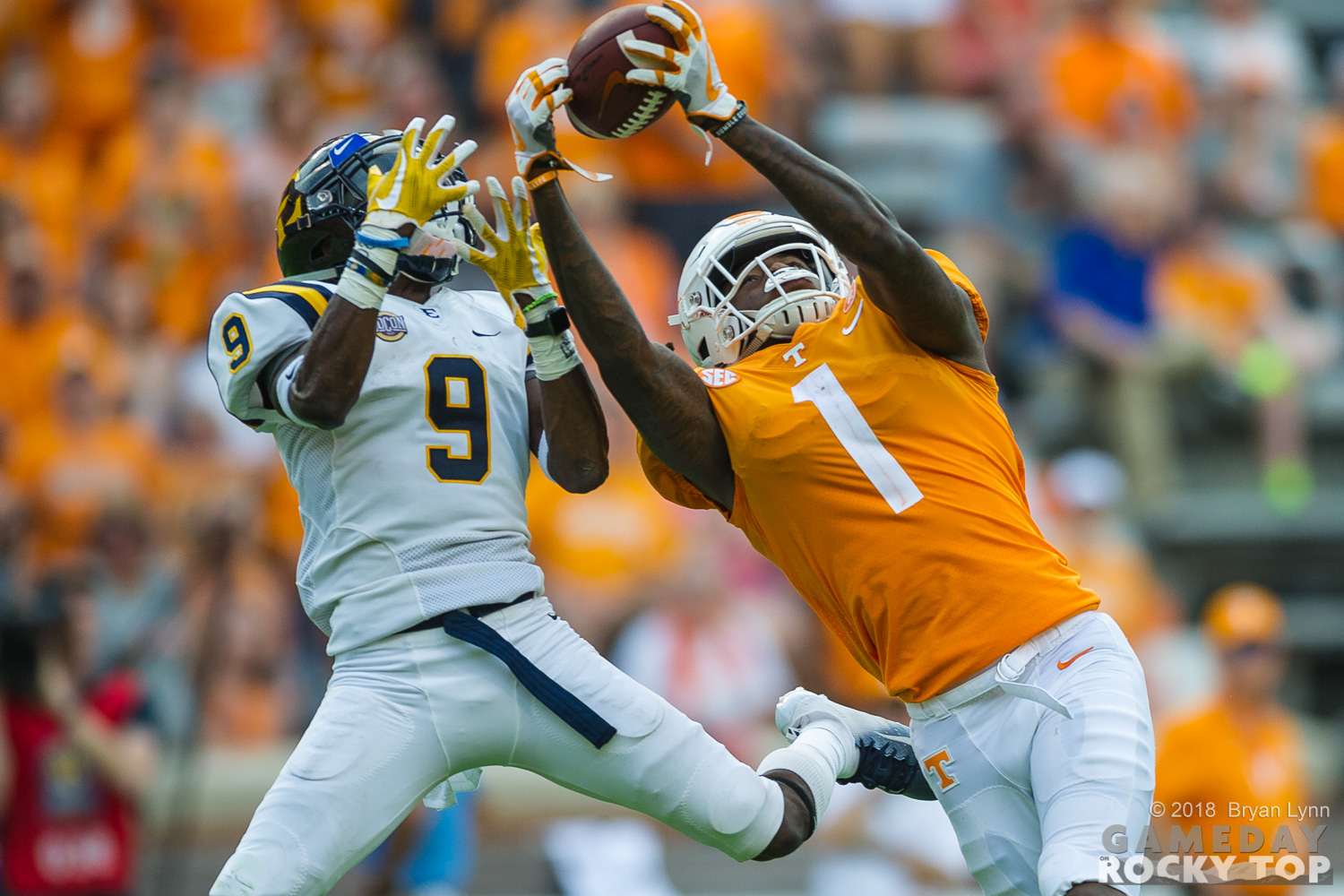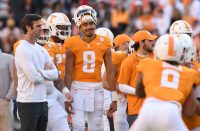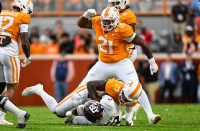If the Vols do meet their rounded-up FPI projection and turn 7.6 wins into an 8-4 regular season, then take what would be a pretty solid bowl victory? There’s a good chance Jeremy Pruitt’s second squad would finish the season in the Top 25. A pair of 9-4 finishes got the Vols a #22 final ranking in 2015 and 2016.
One thing stood out when researching pre-and-postseason polls in the media guide: since 1970, the Vols have only gone from unranked in preseason to ranked at the end of the year twice: SEC Championships in 1985 and 1989.
Some of it is the extremes of Tennessee’s history. Both in the last decade and the period that most mirrors it in the early 1980’s, the Vols had plenty of opportunity: Tennessee went unranked in the preseason poll from 1976-1985, but only got there at the end of the season in that magical ’85 campaign. And the Vols went unranked in the preseason poll from 2009-2014, but never capitalized on any of those opportunities.
After the SugarVols season in ’85, Tennessee was ranked in the preseason AP poll every year from 1986-2008 except one: 1989, when the Vols followed a 5-6 campaign in 1988 with an 11-1 season and a top five finish.
In this sense, we really haven’t seen the kind of year Jeremy Pruitt has a chance to create this fall. We’ve seen unranked-to-top-five, and we’ve seen it the other way around. But a season of significant but not meteoric progress, where the Vols went from unranked to a finish in the back end of the poll? That would be new.
Think of it this way: when’s the last time a Tennessee team overachieved?
In relative terms, I’d probably go with Derek Dooley’s first team in 2010, which finished 6-7 but, as we know, had outcomes overturned against LSU and North Carolina. The narrative of that season, with Tyler Bray’s arrival in November and competitive losses to good teams from LSU and South Carolina, built hope in the immediate aftermath of burning couches. As we also know, that kind of season is no promise of the future; Dooley wasn’t the guy. But other than that year, I’m not sure any of the post-Fulmer teams have ended a year better than we thought they’d be at its beginning.
Fulmer himself pulled it off multiple times, and was also here long enough to experience his share of underachieving. If you’re looking at pre-to-postseason AP poll data, here are the most significant leaps and falls since Johnny Majors got the Vols back in the national picture in the 1980’s:
Leaps
- As mentioned, the Vols started the season unranked in 1985 but won the SEC at 8-1-2, then throttled #2 Miami in the Sugar Bowl to finish #4. In 1989, the Vols lost only to Alabama and went from unranked to #5.
- The Majors-to-Fulmer transition year in 1992 featured a gain of +10 in the final poll. Tennessee began the year at #22, moved to #8 after Fulmer-led wins over #20 Georgia and #14 Florida, and rose as high as #4 as Majors returned from heart surgery in October. Three straight losses by nine total points knocked the Vols back to #23 and essentially ended Majors’ time, but a big win over #16 Boston College in the Hall of Fame (now Outback) Bowl ended Tennessee’s year at #12.
- The National Championship season in 1998 started at #10 and finished, you know, at #1, for a gain of +9. The only national champions who started farther back in the BCS/CFP era (via Wikipedia): Oklahoma in 2000 (#19), Ohio State in 2002 (#13), LSU in 2003 (#14), Auburn in 2010 (#22), and Florida State in 2013 (#11).
- In 1995 and 2001, the Vols went from top ten to top five. Peyton Manning’s sophomore team went from #8 to #3 (and #2 in the coaches’ poll), and Casey Clausen’s 2001 squad went from #8 to #4. Both were legitimate national championship contenders.
Falls
- Like the leap from unranked-to-top-five, the Vols also went top-five-to-unranked twice. A beat-up 2002 squad started #4 but exited the poll after their fourth loss to a Top 20 foe via #1 Miami and never returned thanks to Maryland in the Peach Bowl. And in 2005 the Vols started #3 but a quarterback controversy and five top ten opponents spelled doom, with the Vols out of the poll by November.
- The biggest fall after those? Butch Jones’ infamous 2016 season, which looks even worse in this context. The Vols started at #9, dropped to #17 after a near-miss with Appalachian State, then worked their way back there after a 5-0 start. They stayed there after a double overtime loss to #8 Texas A&M. But it all went downhill from there. The win over #24 Nebraska in the Music City Bowl got them back in the final poll at #22, but a -13 drop is the worst for any Tennessee team that both started and finished the season ranked in the modern era.
- The combination of injured quarterback and obvious rebuilding year created drops that were based as much on Tennessee’s name brand in the preseason poll as anything else. In 1994 the Vols started #13 and finished #22. And in 2000 the Vols started #13 and finished #25.
- A pair of nowhere to go but down years: the Vols were #2 in preseason polls in 1996 and 1999, but finished #9 both years.
- Phillip Fulmer’s final team in 2008 started the year at #18 but finished unranked.
No one is expecting or asking for Jeremy Pruitt to take the 2019 Vols from unranked to an SEC Championship (except Colin Cowherd, apparently). But a tangible sense of major progress, winning a couple games above your preseason expectation and living into the optimism this fanbase would eat up? I’m not sure we’ve ever had a year like that in my lifetime.
And man, it would be a lot of fun.





For the sake of completeness, and because I’m a massive nerd here’s the other years we went from unranked to ranked. 1936 – #17(6-2-1) 1941 – #18(8-2) 1949 – #17(7-2-1) 1965 – #7(8-1-2) 1970 – #4(11-1) In 36′ Neyland was just coming back to the team after Bill Britton took over during his Panama Canal deployment, so expectations weren’t very high after a 4-5 season in 35′. The Vols opened just 1-2 with losses to UNC and Auburn but turned around and shocked #2 Duke during a 5-0-1 run to finish the season. 1941 was John Barnhill’s first season as… Read more »
Massive nerds unite!